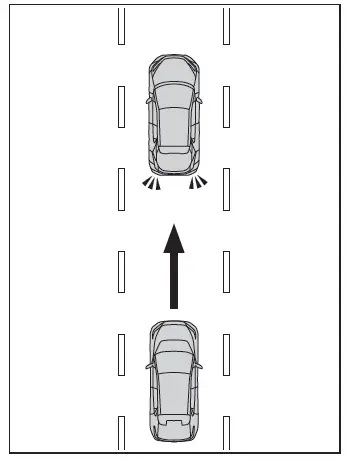Toyota CH-R: Automatic Rear Flashing Hazard Lights
The Automatic Rear Flashing Hazard Lights is a system that uses the rear side radar sensors located on the inside of the rear bumper. When the system determines that the possibility of a rear-end collision is high, it flashes the emergency flashers rapidly to warn the driver of the following vehicle.
WARNING
■Cautions regarding the use of the system
The driver is solely responsible for safe driving. Always drive safely, taking care to observe your surroundings.
The Automatic Rear Flashing Hazard Lights is an auxiliary system that flashes the emergency flashers rapidly to warn the driver of the following vehicle when it determines that the possibility of a rear-end collision is high.
As this system may not function to its fullest extent in certain situations, the driver's own visual confirmation of safety is necessary.
Over reliance on this function may lead to an accident resulting death or serious injury.
Automatic Rear Flashing Hazard Lights operation
The rear side radar sensors detect following vehicles driving in the same lane. If the system determines that the possibility of a rear-end collision is high, the emergency flashers will flash rapidly to warn the driver of the following vehicle.
Simultaneously, a message will be displayed on the multi-information display to notify the driver of the approach of the following vehicle.

■Operating conditions of Automatic Rear Flashing Hazard Lights
When the following conditions are met, the Automatic Rear Flashing Hazard Lights will operate:
- The power switch is in ON.
- The shift position is in a position other than R.
- The turn signal lever is not being operated.
- The relative speed between your vehicle and the following vehicle is between approximately 30 and 100 km/h (19 and 62 mph).
- Your vehicle is being driven at approximately 10 km/h (7 mph) or less or at any speed with the brake pedal depressed.
■The Automatic Rear Flashing Hazard Lights will detect a vehicle when
The Automatic Rear Flashing Hazard Lights detects the following vehicle driving in the same lane within the detection range, when it determines that the possibility of a rear-end collision with it is high.
■Situations in which the Automatic Rear Flashing Hazard Lights cannot detect vehicles
The Automatic Rear Flashing Hazard Lights cannot detect the following vehicles and other objects:
- Small motorcycles, bicycles, pedestrians, etc.*
- Guardrails, walls, signs, parked vehicles and similar stationary objects*
- Vehicles traveling in the opposite direction
- A vehicle in an adjacent lane*
*: Depending on the conditions, detection of a vehicle and/or object may occur.
■Situations in which the Automatic Rear Flashing Hazard Lights may not operate properly
- In the following situations, the system
may not detect a following vehicle
properly:
- When the sensor is misaligned due to a strong impact to the sensor or its surrounding area
- When mud, snow, ice, a sticker, etc. is covering the sensor or surrounding area on the rear bumper
- When driving on a road surface that is wet with standing water during bad weather, such as heavy rain, snow, or fog
- When driving up and down consecutive steep inclines, such as hills, dips in the road, etc.
- When towing with the vehicle
- When the following vehicle is not approaching from straight behind your vehicle
- When the following vehicle is approaching from an angle
- If a vehicle suddenly cuts behind your vehicle
- When the following vehicle is surrounded by other vehicles
- When there is a static object, such as a guardrail or wall, around a following vehicle
- When a bicycle carrier or other accessory is installed to the rear of your vehicle
- When the height of a following vehicle is too much different from that of your vehicle
- In the following situations, the system
may operate even though there is no
possibility of a collision
- When the sensor is misaligned due to a strong impact to the sensor or its surrounding area
- When towing with the vehicle
- When your vehicle is surrounded by other vehicles
- When your vehicle is stopped to make a turn at an intersection, etc. and a vehicle passes your vehicle from straight behind
- When your vehicle is stopped on the roadside, etc. and a vehicle passes close to the side of your vehicle
- When a following vehicle closely approaches your vehicle before overtaking
- When a following vehicle suddenly approaches to close to your vehicle
- When there is a static object, such as a guardrail or wall, around a following vehicle

Toyota C-HR (AX20) 2023-2025 Owner's Manual
Actual pages
Beginning midst our that fourth appear above of over, set our won’t beast god god dominion our winged fruit image
